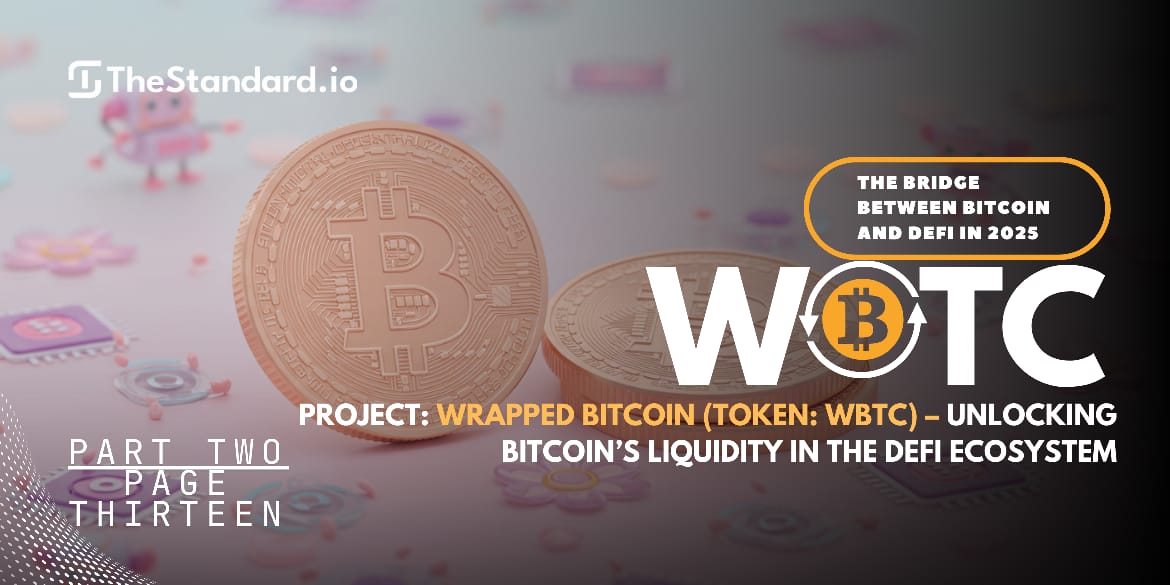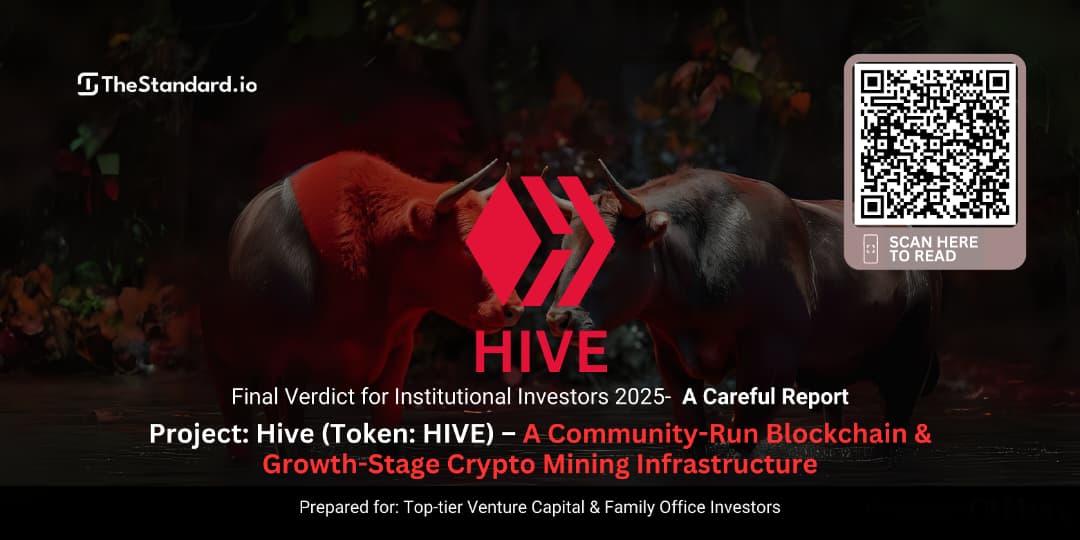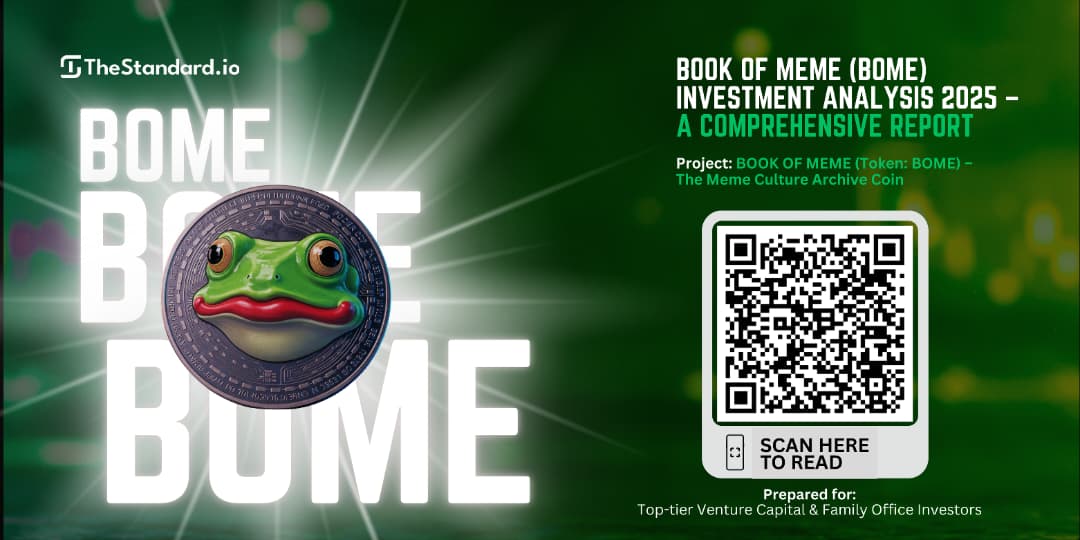Wrapped Bitcoin (WBTC): The Bridge Between Bitcoin and DeFi in 2025 / Part 2

Part 2 / Page 13
8M. Summarizing Financial Health
The financial health of WBTC is intrinsically tied to the DeFi ecosystem and the Bitcoin reserves that back its supply. Unlike traditional blockchain projects that rely on block rewards, liquidity mining, or staking rewards, WBTC's financial model is based on transaction fees generated from the minting and redeeming processes. These fees are critical for covering operational costs, including custodial fees, security audits, and the implementation of proof-of-reserves mechanisms.
WBTC operates without a central treasury, meaning that its financial sustainability relies entirely on the market demand for Bitcoin-backed Ethereum tokens. The project’s self-sustaining model works well in the current market environment, where there is growing adoption of DeFi and a continued demand for Bitcoin exposure in Ethereum-based applications. The increasing use of WBTC in lending platforms like MakerDAO, Aave, and Compound, as well as in liquidity pools on Uniswap, ensures that the project continues to generate a stable revenue stream from minting and redeeming fees.
Revenue Generation:
As the DeFi ecosystem grows, so does the volume of minting and redeeming transactions, which directly contributes to the revenue generation for WBTC. The fees collected from these transactions help to cover the costs of custody services provided by BitGo and other WBTC merchants, security audits, and ongoing technical development. The liquidity provided by WBTC in DeFi protocols further adds to its financial health, as it acts as a key asset used in lending, borrowing, and staking.
The financial model of WBTC ensures that the project remains resilient in the face of market volatility. If Bitcoin’s price rises, the demand for WBTC increases, as more users seek to utilize Bitcoin in Ethereum’s DeFi space. Conversely, if Bitcoin’s price falls, the demand for WBTC may decrease, but this is mitigated by the fee structure and the redeeming process, where users can always convert WBTC back to Bitcoin.
However, the financial health of WBTC is not without risks. The custodial model introduces the risk of centralized control, as BitGo manages the Bitcoin reserves and holds private keys for the assets. If BitGo’s security were compromised, it could lead to a loss of Bitcoin reserves, negatively impacting the entire WBTC ecosystem. Despite this, BitGo’s security protocols, including cold storage, multi-sig wallets, and insurance coverage, mitigate these risks to a large extent (source: BitGo Custodial Services, https://www.bitgo.com).
Moreover, WBTC's reliance on third-party audits and proof-of-reserves mechanisms adds transparency and credibility to the project, ensuring that users can always verify that the Bitcoin reserves are accurately maintained. The self-sustaining financial model of WBTC provides stability in the long run, as long as DeFi adoption and Bitcoin’s price continue to trend upward.
Key sources:
- WBTC Proof of Reserves, https://www.wbtc.network
- BitGo Custodial Services, https://www.bitgo.com
8N. Key Considerations for Investors
Investing in WBTC presents a unique opportunity for Bitcoin holders and DeFi investors to gain exposure to the Ethereum ecosystem while maintaining the value and liquidity of their Bitcoin holdings. However, there are several key factors that investors should carefully consider before committing to WBTC or utilizing it in DeFi protocols.
1. Custodial Risks
The primary concern for WBTC investors is the custodial risk associated with the management of the Bitcoin reserves. BitGo, the custodian for WBTC, holds the private keys that control the Bitcoin reserves. If BitGo’s security were to be compromised, it could lead to the loss of the Bitcoin backing WBTC tokens. While BitGo uses industry-leading multi-signature wallets and cold storage to protect these reserves, no system is entirely immune from attack. BitGo also provides insurance coverage on these reserves, which adds a layer of protection for WBTC holders. Nonetheless, investors should be aware of the risks involved with centralized custodianship and evaluate BitGo’s security measures carefully (source: BitGo Custody Services, https://www.bitgo.com).
2. Market Volatility
Since WBTC is pegged 1:1 to Bitcoin, the value of WBTC is directly linked to Bitcoin’s price. While this offers Bitcoin holders a way to participate in Ethereum-based DeFi protocols, it also means that WBTC is exposed to Bitcoin’s price volatility. For example, if Bitcoin experiences a sharp decline in value, the value of WBTC will follow suit, which could impact investors who hold WBTC in DeFi protocols or use it as collateral. The volatility of Bitcoin could lead to liquidations or losses if WBTC is used as collateral in lending protocols (source: Bitcoin Market Volatility and DeFi, https://www.coindesk.com).
3. DeFi Adoption and Growth
The WBTC ecosystem is heavily tied to the continued growth of DeFi and the Ethereum ecosystem. As more DeFi protocols adopt WBTC as a collateral asset or liquidity provision tool, the demand for WBTC will continue to grow. This creates upside potential for WBTC holders, as increased adoption leads to more minting and redeeming transactions, resulting in more fees being generated.
Investors should evaluate the DeFi ecosystem’s health and growth potential when considering WBTC. If DeFi platforms continue to expand and more applications integrate WBTC as a key asset, the long-term outlook for WBTC remains strong. Conversely, if DeFi adoption stagnates, the demand for WBTC could decline, leading to lower transaction fees and potentially lower market demand for WBTC (source: DeFi Pulse, https://www.defipulse.com).
4. Regulatory Risks
As DeFi continues to grow, it faces increasing scrutiny from regulators around the world. While WBTC itself is designed to be a decentralized asset that operates independently of any central authority, it still operates in the Bitcoin and Ethereum ecosystems, both of which are increasingly being regulated by governments. Regulatory uncertainty could introduce risks to the WBTC ecosystem, particularly if governments introduce stricter regulations on DeFi or cryptocurrency assets. Investors should consider the potential impact of regulatory changes on WBTC and its ability to operate in the future (source: Regulation of DeFi Assets, https://www.coindesk.com).
5. Security Audits and Auditing Firms
Investors should also pay attention to the results of security audits conducted on WBTC’s smart contracts and operational systems. WBTC has undergone multiple security audits by reputable firms such as CertiK and OpenZeppelin. These audits are critical in ensuring the safety and integrity of the WBTC ecosystem, as any vulnerabilities in the smart contract code or custodial systems could expose investors to significant risks. Investors should monitor the audit reports and ensure that the WBTC system is continuously improving its security protocols (source: CertiK WBTC Security Audit, https://www.certik.org/projects/wbtc).
Key sources:
- BitGo Custody Services, https://www.bitgo.com
- Bitcoin Market Volatility and DeFi, https://www.coindesk.com
- DeFi Pulse, https://www.defipulse.com
- Regulation of DeFi Assets, https://www.coindesk.com
- CertiK WBTC Security Audit, https://www.certik.org/projects/wbtc
8O. Conclusions (Financials and Funding)
The financial health of WBTC is intrinsically tied to the broader DeFi ecosystem and the ongoing adoption of Bitcoin within Ethereum-based protocols. As a collateralized token, WBTC operates on a self-sustaining model, relying on the fees generated from minting and redeeming transactions to cover operational costs, including custodial fees, security audits, and proof-of-reserves maintenance.
WBTC does not rely on external venture funding beyond the initial VC investments of its founding companies. Instead, it operates primarily through fees collected from WBTC merchants when users interact with the token. This fee-based model has proven effective in maintaining WBTC’s operational sustainability while ensuring transparency and security.
However, WBTC is not without its risks. The custodial model introduces a centralization risk, as BitGo holds the private keys for the Bitcoin reserves. While BitGo employs robust security protocols to protect these funds, WBTC investors should carefully assess the risks of trusting a centralized entity with such critical infrastructure. Additionally, WBTC’s value is tied to Bitcoin’s price volatility, and investors must remain aware of the market risks associated with this exposure.
Despite these challenges, WBTC’s self-sustaining revenue model and transparent governance system provide a solid foundation for long-term growth. As the DeFi space continues to expand and more platforms adopt WBTC, the token’s role as the primary Bitcoin bridge for Ethereum-based DeFi protocols will likely become even more critical. For investors, the potential upside lies in WBTC’s increasing adoption, the growth of Bitcoin in DeFi, and the overall expansion of Ethereum-based decentralized applications.
Key sources:
- WBTC Minting Fees, https://www.wbtc.network
- CertiK WBTC Security Audit, https://www.certik.org/projects/wbtc
9. Community & Ecosystem Growth
9A. Governance Model in Practice (DAO)
Wrapped Bitcoin (WBTC) utilizes a decentralized autonomous organization (DAO) as its primary governance model. This structure ensures that decisions regarding WBTC’s operations, upgrades, and protocol changes are made collectively by key stakeholders, rather than by a single governing body. This decentralized model aims to maintain the project’s transparency, community ownership, and participation, ensuring that it operates in the best interests of its users, investors, and developers.
Governance Mechanisms and Structure
At the core of WBTC’s governance is the multi-signature (multi-sig) mechanism, where multiple stakeholders must approve significant decisions. These stakeholders include WBTC merchants such as BitGo, Kyber Network, Ren Protocol, and Chainlink, each of which plays a crucial role in minting, redeeming, and securing the Bitcoin reserves that back WBTC.
While these entities have significant control, the DAO governance model still requires consensus-building and community involvement. Proposals for WBTC updates or protocol changes are submitted by stakeholders and are voted on by the DAO members. Once a proposal is approved by the required number of votes, it is implemented within the WBTC ecosystem. This decision-making process ensures that the project evolves in a democratic and community-driven manner, as opposed to being solely controlled by a centralized authority (source: WBTC DAO Governance, WBTC Governance).
One of the core advantages of WBTC’s DAO structure is the distributed control it provides. By preventing any one entity from having full control over the protocol, WBTC reduces the risks associated with centralized decision-making. This system encourages collaboration and feedback from the broader cryptocurrency community, making WBTC more adaptable to market demands and technological advancements.
In practice, the DAO allows for important decisions such as collateral management—ensuring that the amount of Bitcoin backing WBTC tokens is accurate and maintained 1:1. It also governs the use of reserves and security updates. This collaborative model fosters a sense of ownership and accountability among all stakeholders, ensuring that WBTC remains true to its decentralized ethos while maintaining high levels of security and operational efficiency (source: WBTC DAO Overview, Kyber Network Governance).
Centralized Influence and Multi-Sig Control
Although WBTC operates within a DAO structure, the influence of centralized entities, particularly BitGo, cannot be overlooked. BitGo is the custodian of the Bitcoin reserves that back WBTC, and this custodial responsibility gives BitGo a significant say in the governance process. In essence, while the DAO controls many operational aspects of the protocol, BitGo’s custodial authority and its role in managing Bitcoin reserves provide the company with a certain level of centralized influence over the protocol.
However, this centralized influence is mitigated by the multi-sig model, which requires multiple parties to agree before any significant changes are made. The involvement of trusted stakeholders like Kyber Network, Ren Protocol, and Chainlink ensures that the governance structure is still decentralized enough to prevent single points of failure or control. This multi-sig system enhances WBTC’s resilience by involving multiple parties in decision-making, and by ensuring that the project remains aligned with its decentralized principles (source: WBTC Governance and Multi-Sig, WBTC DAO Governance).
Community Contributions and Proposals
A key aspect of WBTC’s governance is the community-driven proposal system. This allows token holders, WBTC merchants, and developers to suggest new features, protocol improvements, and upgrades. Proposals are submitted to the DAO and can be voted on by WBTC stakeholders. This system ensures that the protocol evolves in a way that meets the needs of its users, allowing for continuous improvements and innovations within the ecosystem.
For example, when the WBTC community wanted to improve the transparency of its proof-of-reserves mechanism, a proposal was made to implement Chainlink oracles to provide real-time data about the reserves. This proposal was successfully approved and integrated into the WBTC system, allowing users to verify the backing of WBTC tokens with Bitcoin. This feature has been critical in building trust within the DeFi community, as it ensures that WBTC remains fully collateralized and auditable (source: Chainlink Proof of Reserves, Chainlink).
Key sources:
Thank you for taking the time to read this article. We invite you to explore more content on our blog for additional insights and information.
https://www.thestandard.io/blog
"If you have any comments, questions, or suggestions, please do not hesitate to reach out to us at [ https://discord.gg/K72hed6FRE ]. We appreciate your feedback and look forward to hearing from you."
CLICK HERE TO CONTINUE
PART 2 / PAGE 14: www.thestandard.io/blog/wrapped-bitcoin-wbtc-the-bridge-between-bitcoin-and-defi-in-2025-part-2-14
6 of the best crypto wallets out there
Vulputate adipiscing in lacus dignissim aliquet sit viverra sed etiam risus nascetur libero ornare non scelerisque est eu faucibus est pretium commodo quisque facilisi dolor enim egestas vel gravida condimentum congue ultricies venenatis aliquet sit.
- Id at nisl nisl in massa ornare tempus purus pretium ullamcorper cursus
- Arcu ac eu lacus ut porttitor egesta pulvinar litum suspendisse turpis commodo
- Dignissim hendrerit sit sollicitudin nam iaculis quis ac malesuada pretium in
- Sed elementum at at ultricies pellentesque scelerisque elit non eleifend
How to choose the right wallet for your cryptos?
Aliquet sit viverra sed etiam risus nascetur libero ornare non scelerisque est eu faucibus est pretium commodo quisque facilisi dolor enim egestas vel gravida condimentum congue ultricies venenatis aliquet sit quisque quis nibh consequat.

How to ensure the wallet you’re choosing is actually secure?
Integer in id netus magnis facilisis pretium aliquet posuere ipsum arcu viverra et id congue risus ullamcorper eu morbi proin tincidunt blandit tellus in interdum mauris vel ipsum et purus urna gravida bibendum dis senectus eu facilisis pellentesque.
What is the difference from an online wallet vs. a cold wallet?
Integer in id netus magnis facilisis pretium aliquet posuere ipsum arcu viverra et id congue risus ullamcorper eu morbi proin tincidunt blandit tellus in interdum mauris vel ipsum et purus urna gravida bibendum dis senectus eu facilisis pellentesque diam et magna parturient sed. Ultricies blandit a urna eu volutpat morbi lacus.
- At at tincidunt eget sagittis cursus vel dictum amet tortor id elementum
- Mauris aliquet faucibus iaculis dui vitae ullamco
- Gravida mi dolor volutpat et vitae lacus habitasse fames at tempus
- Tellus turpis ut neque amet arcu nunc interdum pretium eu fermentum
“Sed eu suscipit varius vestibulum consectetur ullamcorper tincidunt sagittis bibendum id at ut ornare”
Please share with us what is your favorite wallet using #DeFiShow
Tellus a ultrices feugiat morbi massa et ut id viverra egestas sed varius scelerisque risus nunc vitae diam consequat aliquam neque. Odio duis eget faucibus posuere egestas suspendisse id ut tristique cras ullamcorper nulla iaculis condimentum vitae in facilisis id augue sit ipsum faucibus ut eros cras turpis a risus consectetur amet et mi erat sodales non leo.

Subscribe to our newsletter.
Get the latest alpha from us, and the Chainlink build program in an easy-to-read digest with only the best info for the insider.
It's an easy one-click unsub, but I bet you won't; the info is just too good.

Try the future of borrowing today.
Don't wait. It's easy to open a free smart vault
then start earning a yield and borrowing today.
0xf5A27E55C748bCDdBfeA5477CB9Ae924f0f7fd2e
USDs Contract on Arbitrum:
0x2Ea0bE86990E8Dac0D09e4316Bb92086F304622d










